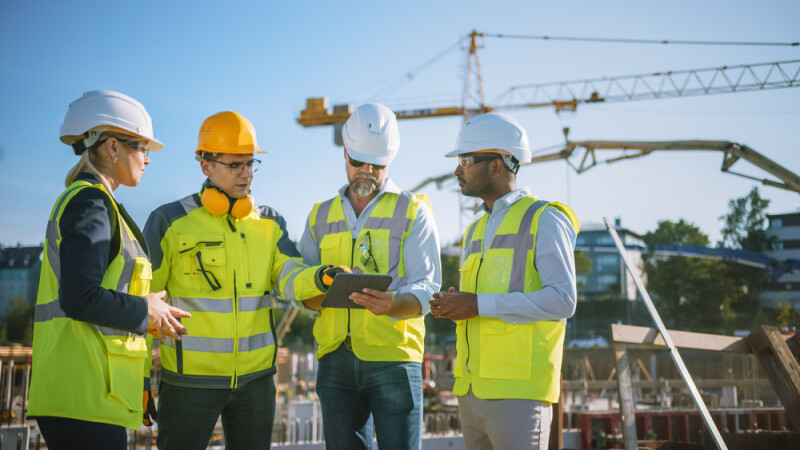by Manish Sharma, Chief Product Officer for the Build & Construct Division of the Nemetschek Group
Each new year brings resolutions, often aimed at improving efficiency, enhancing growth, and setting new standards. This year, construction leaders are encouraged to adopt a resolution that goes beyond individual gains: making sustainability a foundational priority across the industry.
Sustainability has evolved from a trend to a core expectation in the construction industry, influencing how projects are designed, executed, and maintained. Today, increased regulatory pressure and client demand make reducing environmental impact essential.
As the Chief Product Officer for the Build & Construct Division of the Nemetschek Group, I have a front-row seat to how construction technology innovations can reduce waste, conserve energy, and optimize sustainable design.
However, technology alone only lays the groundwork for sustainable success; true impact is achieved when collaboration between all stakeholders becomes a standard practice. By breaking down silos and employing digital tools holistically, such as adopting paperless workflows, the construction industry can embed sustainability into every phase of the project lifecycle.
From Trend to Necessity: Sustainability’s Growing Role in Construction
Sustainability is no longer an option in construction; it’s a demand that drives nearly every major project decision. The construction industry, responsible for nearly 40 percent of global carbon emissions, holds a critical role in environmental change. Regulatory agencies have responded by implementing increasingly strict standards that push for eco-friendly designs, reduced emissions, and more careful energy use.
While most construction professionals agree on sustainability's importance, challenges remain. According to a recent survey commissioned by Bluebeam, only half of respondents believe their companies' sustainability efforts have been successful. Even more revealing, the majority of companies allocate less than 25 percent of their budgets to sustainability initiatives. Despite this, the same survey indicates optimism, as many predict sustainability budgets to increase in the coming year.
At the same time, investors, developers, and tenants are raising their expectations. Clients increasingly seek energy-efficient and sustainable buildings, and structures designed with these priorities often command higher rents and stronger market value. Companies that fail to emphasize sustainability in their operations risk losing competitiveness in a landscape where eco-friendly expertise is becoming essential.
Digital Tools: Empowering Green Construction Practices
New digital tools empower project teams to set and achieve green goals, providing practical ways to incorporate sustainability into everyday processes. Digital collaboration platforms facilitate effective communication, streamline project workflows, and embed sustainable targets from the start.
For example, digital project management tools track materials in real-time, allowing teams to order only what’s necessary and reduce the waste of over-ordering. Building information modeling (BIM) enables architects and engineers to design efficient structures and run simulations that reveal opportunities for energy conservation before construction begins. On-site, Internet-of-Things (IoT) technology monitors energy usage and identifies efficiency opportunities on a real-time basis.
These tools are not only environmentally beneficial - they are also cost-effective. Projects that incorporate digital collaboration see reduced delays, material costs, and resource consumption, resulting in significant financial savings. When sustainability aligns with financial goals, it presents a compelling win-win.
Paperless Workflows: Reducing Embodied Carbon and Improving Efficiency
One of the most impactful ways construction can reduce environmental harm is through paperless operations. By digitizing processes like document management and project tracking, teams can identify potential issues earlier in the AEC lifecycle. Addressing these challenges proactively reduces embodied carbon by minimizing rework and waste.
Moreover, paperless workflows optimize field worker productivity - a critical need as the industry faces skilled labor shortages. By eliminating time-consuming manual processes, field teams can focus on high-value tasks that improve project outcomes and reduce environmental impacts. This dual benefit of operational efficiency and sustainability makes paperless tools indispensable for the future of construction.
Breaking Down Silos: Collaboration’s Role in Sustainable Success
While technology is essential, it reaches its full potential only in a collaborative setting. Too often, sustainability goals are disrupted by industry silos—architects working in isolation from engineers, engineers disconnected from contractors. When teams work with distinct objectives rather than as a cohesive unit, sustainability targets are often deprioritized or misaligned.
Respondents in the Bluebeam survey ranked energy efficiency as the most important principle of sustainable construction, followed by the use of durable building materials. To achieve these objectives, collaboration ensures that all stakeholders - architects, engineers, contractors, and owners - are aligned with shared goals. By integrating digital tools across all teams and project phases, sustainability becomes a foundational part of the workflow rather than an afterthought.
This unified approach allows for more effective decision-making, as all teams are equipped to prioritize sustainability within their roles. This drives efficiencies and positive environmental impacts across the project, ultimately enhancing both the company’s bottom line and its environmental footprint.
Sustainability: A Competitive Edge for Construction Leaders
Sustainability yields business benefits beyond environmental stewardship. Companies that integrate sustainable practices enjoy reduced operating costs from lower energy usage, minimized waste, and streamlined timelines. Moreover, sustainability has become a key differentiator; companies with a reputation for eco-friendly practices increasingly attract property owners, investors, and tenants.
Implementing sustainable practices also future-proofs businesses. Environmental standards are likely to continue tightening, and companies that have already invested in sustainable practices will find themselves well-positioned as these regulations evolve. By taking proactive steps now, construction firms can avoid reactive, last-minute adjustments and instead be prepared for the future of green building.
A Call to Action for the Industry
Looking ahead, construction leaders are encouraged to prioritize sustainability through collaboration, paperless workflows, and digital tools. The way forward involves more than adopting technology; it requires a commitment to a new way of working, one that values shared responsibility, transparency, and environmental stewardship.
Embracing sustainable practices and digital collaboration tools benefits both the planet and profitability. This year, the industry has an opportunity to lead the way in building a resilient future where sustainability is woven into the fabric of every project. Construction companies that prioritize these initiatives not only contribute to the greater good but also secure a place as leaders in an increasingly eco-conscious market.
Let this be the industry’s New Year’s resolution: to make sustainable practices, paperless workflows, and cross-functional collaboration a standard. By aligning all teams around shared environmental objectives, construction leaders can ensure that green building becomes a hallmark of success rather than a challenge to overcome.
The future of the construction industry - and the planet - depends on it.
 Manish serves as SVP M&A Product & Technology for the Nemetschek Group where he oversees Product and Technologies due diligence and Post Merger Integration topics within the M&A process. Manish has over twenty years of product and engineering leadership experience, most recently with Honeywell Buildings.
Manish serves as SVP M&A Product & Technology for the Nemetschek Group where he oversees Product and Technologies due diligence and Post Merger Integration topics within the M&A process. Manish has over twenty years of product and engineering leadership experience, most recently with Honeywell Buildings.






